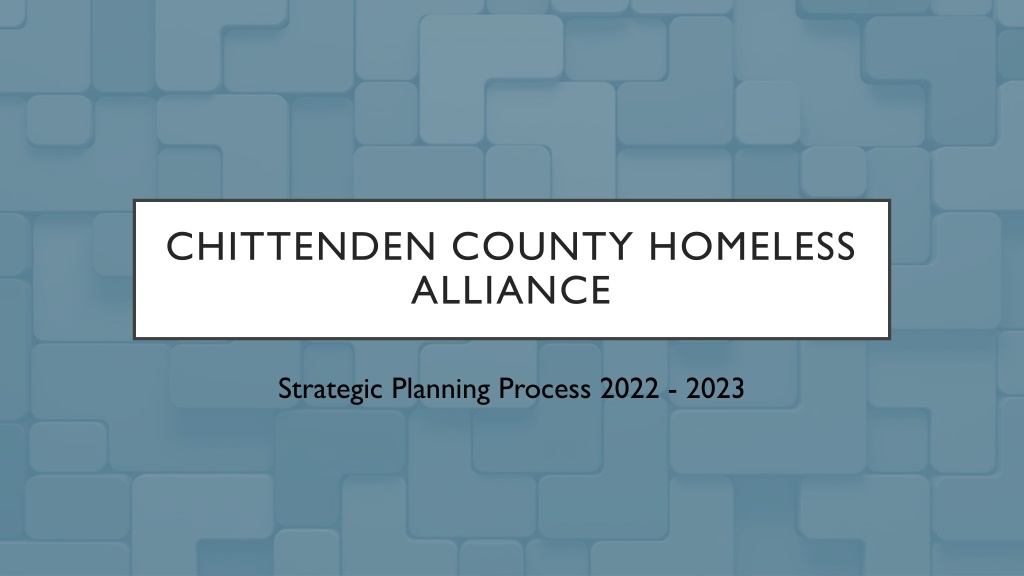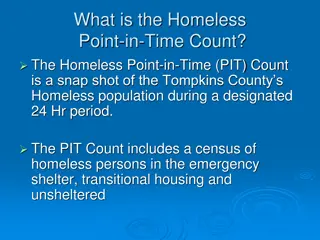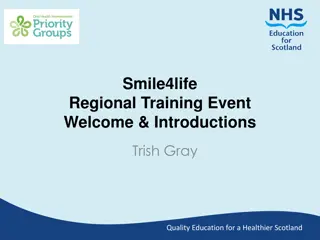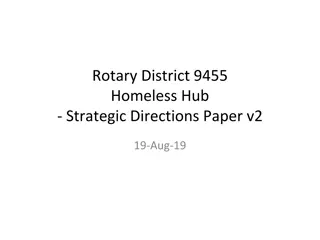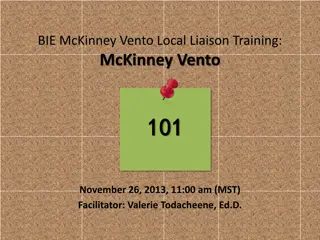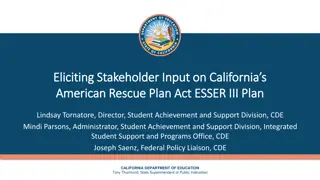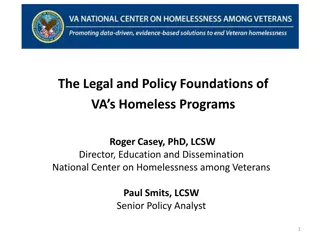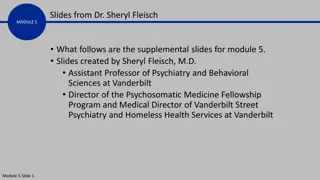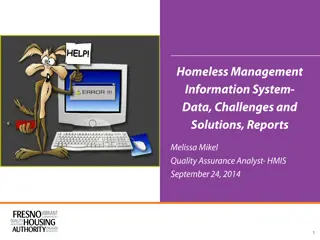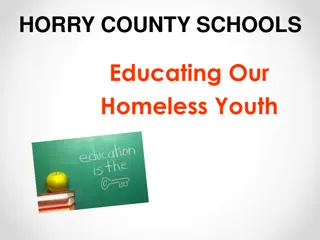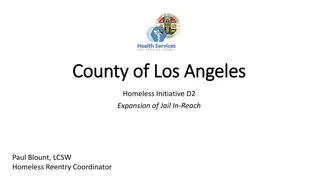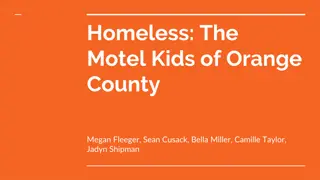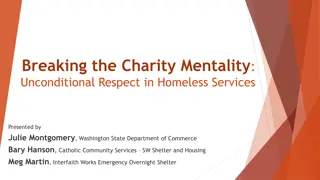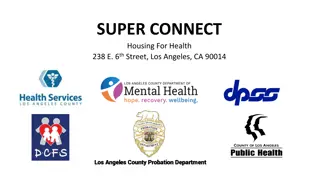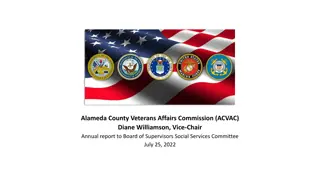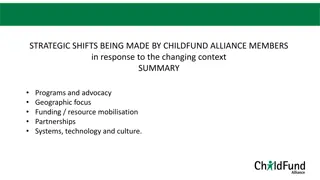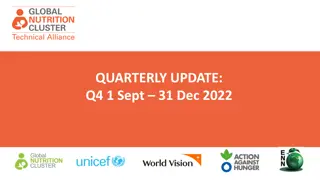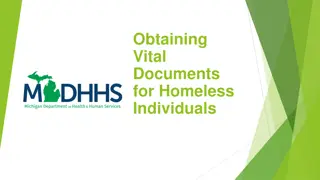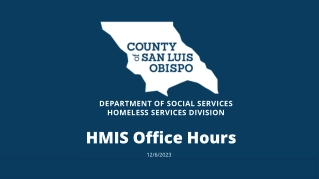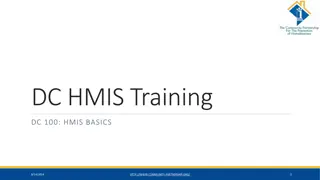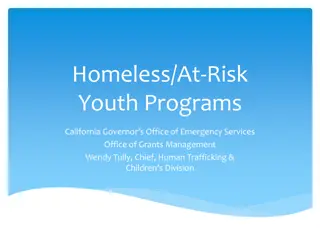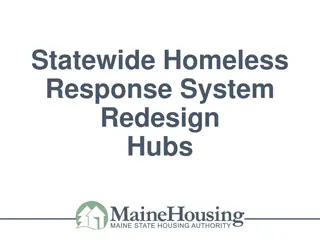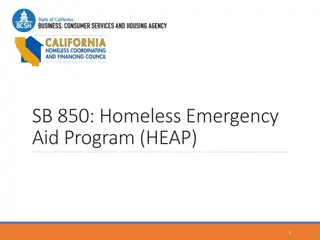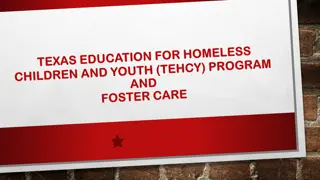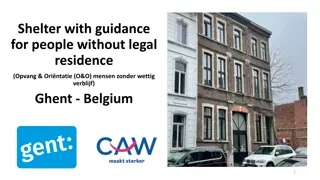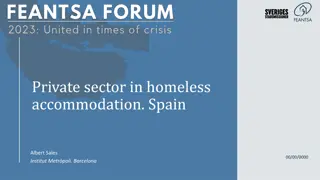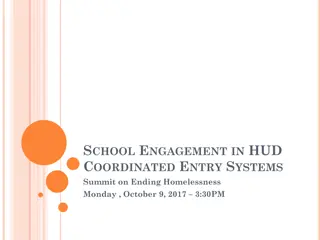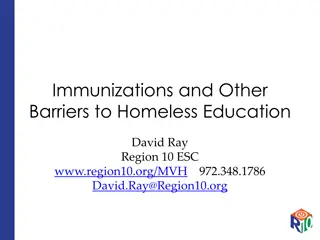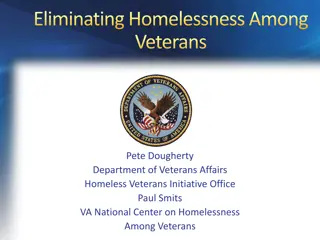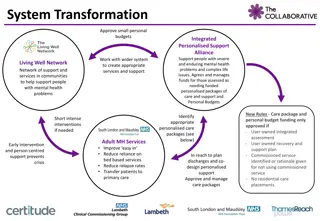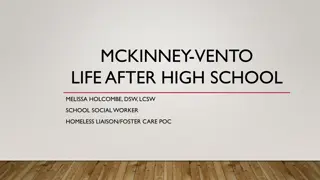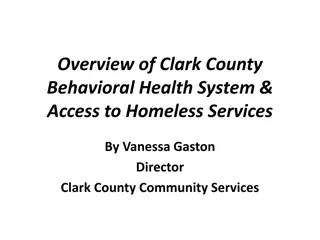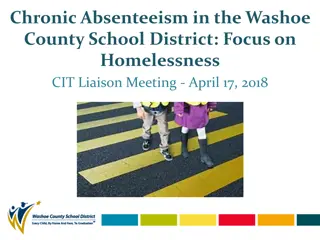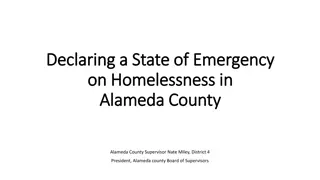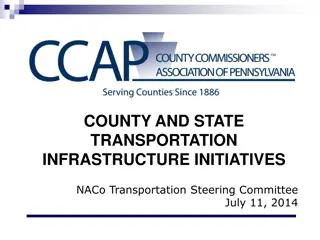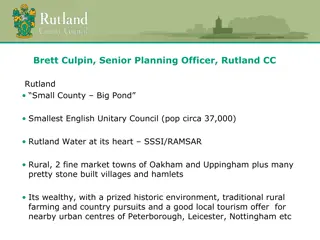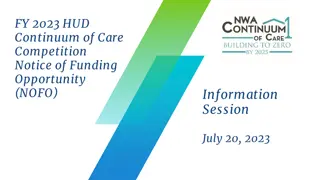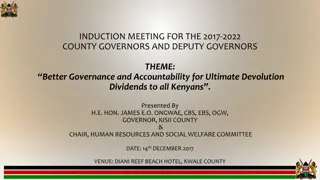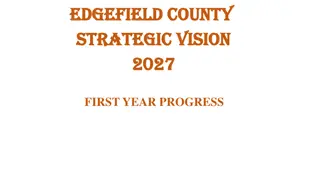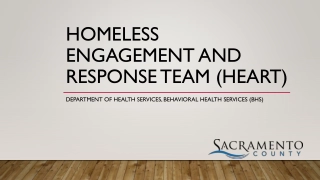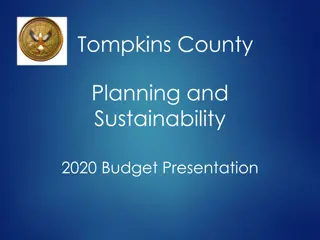Chittenden County Homeless Alliance Strategic Planning Process 2022-2023
Chittenden County Homeless Alliance is a coalition in Vermont focused on providing safe, affordable housing for all. They engage in outreach, education, advocacy, and collaborative actions to address homelessness, allocate resources, and work on prevention strategies. Engaged in various projects, they plan strategically with a vision for a better future.
Download Presentation

Please find below an Image/Link to download the presentation.
The content on the website is provided AS IS for your information and personal use only. It may not be sold, licensed, or shared on other websites without obtaining consent from the author. Download presentation by click this link. If you encounter any issues during the download, it is possible that the publisher has removed the file from their server.
E N D
Presentation Transcript
CHITTENDEN COUNTY HOMELESS ALLIANCE Strategic Planning Process 2022 - 2023
AGENDA Welcome and Introductions Brief History of Alliance Who we are Where we ve been Today s Work What s Next
A long-standing coalition of individuals, organizations, and government entities who have worked together to further the vision of a safe, decent, affordable, stable home for every person and family in Chittenden County, Vermont. WHAT IS THE ALLIANCE ? HUD recognized Continuum of Care for Chittenden County, Vermont
Outreach, Education and Advocacy KEY FUNCTIONS OF ALLIANCE Collaborative Action Resources
Supports training for partners Facilitates regular information sharing and problem-solving meetings and committees Provides data about current conditions OUTREACH, EDUCATION AND ADVOCACY Holds public meetings and forums focused on the efforts of the Alliance and the impacts of homelessness Develops and advocates for programs, funding and policies that further the Mission of the Alliance
Coordinated Entry System Housing Review Committee Homelessness Prevention COLLABORATIVE ACTIONS Retention Services Data and evaluation Planning
Allocates HUD Continuum of Care Program fundings RESOURCES Seeks resources to support core operations, shared services and collaborative functions
COMMENT OR QUESTIONS? DID WE MISS ANYTHING?
The Alliance actively engaged in several planning or evaluation projects between 2016 and 2018. The recommendations in the documents were expected to provide a foundation for establishing priorities and launching actions that would improve the overall operations and impact of the Alliance. Work with Cope and Associates to identify a common agenda and measures WHERE DID WE START? Development of a Strategic Planning Framework that outlines what it would take to achieve the vision of the Alliance Organization Development Plan outlined what the Alliance needs in terms of training, staff and systems to fulfill its role as a hub for projects, activities and programs intended to end homelessness An assessment of the newly launched Coordinated Entry System A report on Addressing Racial Disparities in Homelessness All these documents are available on the Alliance website: cchavt.org
Although there were dozens of recommendations among the plans requiring small, medium and significant effort - they all could be categorized in one of more of six themes: WHERE DID PRIOR PLANNING POINT US? Organizational Development Data and Evaluation Regulatory Education and Advocacy Collaborative Action Diversity and Inclusion
Engage in activities to strengthen relationships and build trust among Alliance members, key community partners and individuals who are, or have, experienced homelessness Engage in Create practices and procedures that integrates, connects and coordinates the work of the Standing Committees with the oversight role of the Steering Committee Create WHAT DID WE INTEND TO DO: Build and clarify ORGANIZATION DEVELOPMENT Build and clarify policies and procedures around key issues like decision- making, setting priorities and how success is measured and monitored Secure Secure funds to support staff and operations Explore innovations and opportunities to better leverage resources, align efforts and improve outcomes Explore
Enhance Enhance ability to collect outcome and compliance monitoring data Engage in organization development efforts to develop and use feedback loops and human centered design Engage in WHAT DID WE INTEND TO DO: Inventory and build DATA AND EVALUATION Inventory and build agreements around data sharing within and outside HMIS system Develop more comprehensive reports that track data quality and the efficiency, effectiveness and impact of services Develop Create a dashboard that looks at trends over time on agreed upon measures and outcomes Create Define Define who is responsible for data mining
Finalize Finalize 5-year strategic Plan Advocate for prompt implementation of 2015 Affirmatively Furthering Fair Housing Policy Advocate WHAT DID WE INTEND TO DO: Develop and launch Develop and launch Coordinated Entry System REGULATORY Clarify documentation needed to designate someone as chronically homeless Clarify Eliminate side doors which keep housing stock from being used by Coordinated Entry Eliminate
Draft data-based information about housing and homelessness and explore ways to use it Draft Develop Develop a process and priorities for an advocacy agenda Raise awareness of racial disparities in housing and homelessness WHAT DID WE INTEND TO DO: Raise COMMUNICATION AND ADVOCACY Increase awareness of discrimination in rental housing market including avenues through which claims can be pursued Increase Continue to advocate for more PSH units, vouchers and subsidies Continue Produce one page list of services available with a map to give to all new consumers Produce
Support the work of all Standing Committees: Outreach and Membership Data, PIT and HMIS NOFA Application Strategic Planning Coordinated Entry and Housing Review Veterans Housing Retention WHAT DID WE INTEND TO DO? COLLABORATIVE ACTIONS Pilot a program that matches people with housemates and offers services Expand landlord liaison programs and guarantees Establish incentive for homeowners to create apartments
Align around meaning of HMIS terms Coordinate and leverage work of BoS Add questions to assessment about what people need and what they find most helpful WHAT DID WE INTEND TO DO: COLLABORATIVE ACTIONS Address issues identified in evaluation about specific fields in HMIS and steps in process map Create or clarify policies and then train individuals to ensure data is consistent across the system Clarify boundaries of Coordinated Entry outline preferred referral processes, etc. Specific recommendations about how to improve the Coordinated Entry System Conduct facilitated meeting housing navigators and BHA to improve transitions
Evaluate and expand efforts to engage individuals with lived experience WHAT DID WE INTEND TO DO: DIVERSITY AND INCLUSION Ensure all agencies serving people experiencing homelessness have access to diversity/equity training
It is important to note that a lot of what we did was not anticipated nor was it planned. It was in response to the Covid 19 pandemic and required an all-in community effort. WHAT WE DID?
ACCOMPLISHMENTS AND ASSETS Launched Coordinated Entry System Continuous focus on improving PIT count process and results Continues to meet regulatory requirement of CDBG allocation process Continuous focus on improving processes of Housing Review Committee Created Housing Retention Committee Added Diversity, Equity and Inclusion statement to Alliance Charter Negotiated agreements with private landlords to use Coordinated Entry System People keep coming. There is a long-term investment among partners and willingness to keep trying to make it work Shared mission and framework that aligns purposes
Community Response to COVID 19 Resources and Practice Communications Increased Capacity COTS, ANEW and Spectrum participated in DOH Infectious Disease Epidemiology meetings to mitigate spread at congregate sites. ANEW Place ran North Beach Campground CVOEO ran Holiday Inn serving hundreds of people CHT ran COVID isolation motel at Ho Hum CVOEO ran Community Resource Center at VFW and then Feeding Chittenden .Spectrum partnered with Feeding Chittenden to deliver meals regardless of age Feed Chittenden provided food for CRC and hotels 10 person FEMA funded Outreach Team offering health and safety supplies and supports Engaged over 600 households a month with Coordinated Entry and securing housing ANEW placed purchased Champlain Inn to increase shelter capacity STEPS secured a new shelter Mobile three-person team bringing services and good to people living on the street Daily and then weekly calls to discuss supplies, outbreaks, vaccinations, testing, staffing, isolation plans and most recent guidance.
COMMENTS OR QUESTIONS? DID WE MISS ANYTHING?
STRATEGIC PLANNING FRAMEWORK LEARNING FROM THE PAST TO BETTER UNDERSTAND THE PRESENT AND POINT TOWARD THE FUTURE. Strategic Planning Framework Charter Organizational Development Plan Coordinated Entry Final Assessment Diversity and Equity Statement Reports and evaluations Shared Measures Updates What did we intend to do? What we did? How does that influence our priorities? What has changed? We are here SWOT analysis Data analysis What do we want to get to get done How do we need to organize to do it
Situationally and individual appropriates services and programs that: PILLARS OF STRATEGIC PLAN Keep people housed Rehouse people as quickly as possible Keep people safe and as stable as possible while they are not housed
PRINCIPLES AND MEASURES OF SUCCESS Guiding Principles Common Measures of Progress Programs and systems are inclusive and culturally competent Number of people experiencing homelessness (rare) Length of time people remain homeless (brief) We engage people with lived experience when we design, implement and evaluate programs and systems The extent to which people who exit homelessness to permanent housing destinations return to homelessness (stable) All interactions are trauma informed We provide multigenerational services to families The extent to which people become homes for the first time (stable) We know people by name and we know what their individual needs are We use standardized assessment at all door so that people have fair and equitable access to resources
Overall Population Comparison Data from 2022 Point-In-Time Count BY THE NUMBERS The next three slides are either replications of slides or based on data presented by Institute for Community Alliances on May 5. 2022 to Chittenden County Homeless Alliance Continuum of Care (CCHA). The whole PowerPoint presentation is available on the CCHA website cchavt.org
TOTAL INDIVIDUALS EXPERIENCING HOMELESSNESS Important Notes: The 2021 PIT count did not include an unsheltered count. All years counts were conducted in the month of January Total persons include all individuals and household types in Emergency Shelter, Transitional Housing, Safe Haven (HUD defined), and Unsheltered (years 2019, 2019, 2020 and 2022) Five Year Comparison 800 700 700 668 600 500 400 359 309 300 261 200 100 0 2018 2019 2020 2021 2022
COMPARISONS OF OTHER POPULATIONS Adults with a Substance Use Disorder Total Adults with a Serious Mental Health Illness 160 236 250 136 140 199 200 120 104 100 150 80 66 95 100 60 40 50 20 0 0 2020 2021 2022 2020 2021 2022
COMPARISONS OF OTHER POPULATIONS Adults with HIV/AIDS Adult Survivors of Domestic Violence 4.5 160 148 4 4 140 3.5 120 3 100 2.5 80 65 2 60 1.5 1 35 40 1 20 0.5 0 0 0 2020 2021 2022 2020 2021 2022
Review and discuss current conditions Brainstorm what you would like to change over the next five years Identify ways the Alliance could support change Conduct a SWOT analysis of the Alliance TODAY S WORK
What most interests or concerns you about the information just presented? CURRENT CONDITIONS
What would you like to see change over the next five years? ASPIRATIONS
How could the Alliance support the changes you ve identified? ROLE OF THE ALLIANCE
How is the Alliance positioned right now to take on the effort needed to bring about change? As one group or two small groups complete SWOT analysis of the Alliance. Strengths and Weaknesses (Internal) Opportunities and Threats (External) SWOT ANALYSIS If two groups begin by designating some one to take notes and report back. Each group will have 15 minutes to brainstorm. Each group will then have up to five minutes to share their brainstorms. The group will have an additional ten minutes to add or clarify items.
WHATS NEXT Focus groups will be happening throughout March and early April Interviews and surveys from people with lived experience will be completed during this same time period Summaries will be prepared and reviewed in late April and early May Draft of the Strategic Plan will be completed by the end of May
COMMENTS OR QUESTIONS? Thank you!
